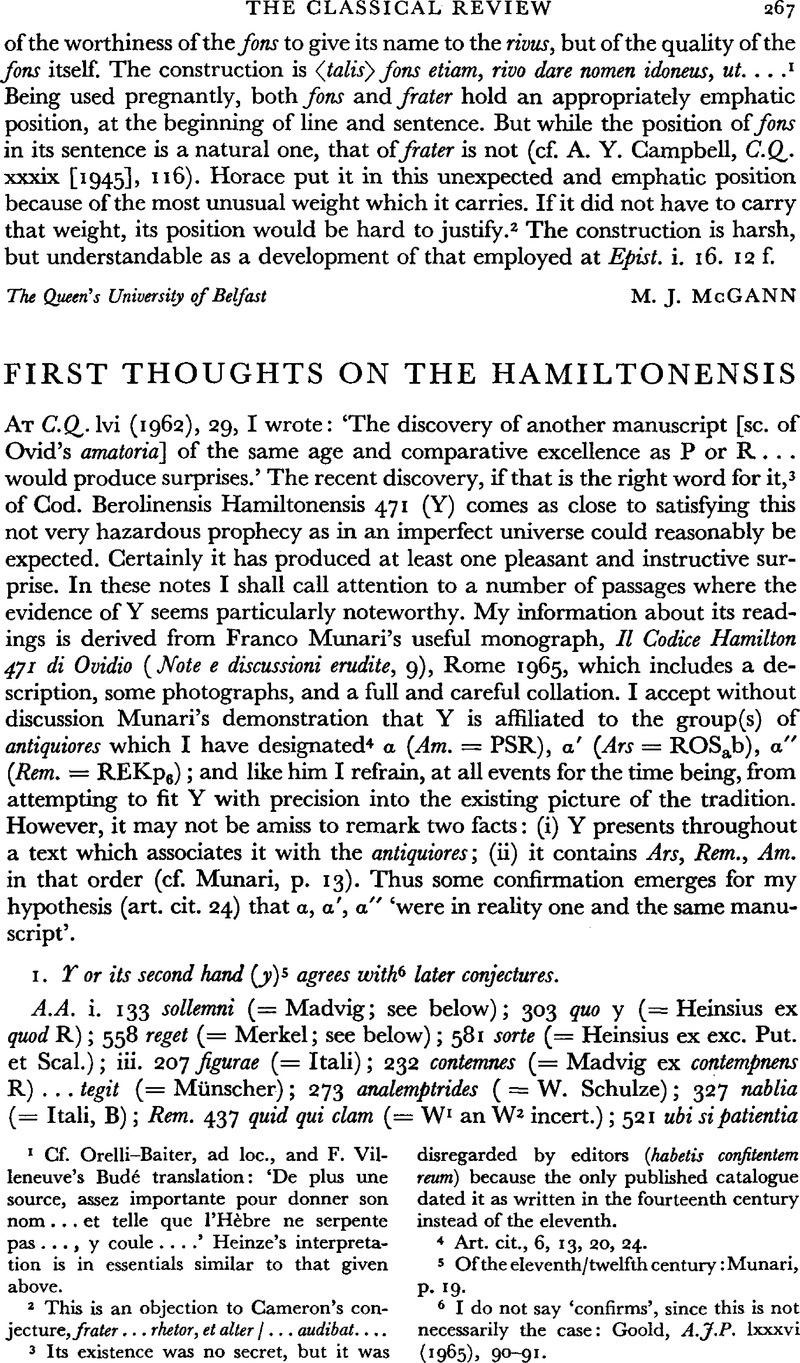Article contents
First thoughts on the Hamiltonensis
Published online by Cambridge University Press: 27 February 2009
Abstract

- Type
- Review Article
- Information
- Copyright
- Copyright © The Classical Association 1966
References
page 267 note 3 Its existence was no secret, but it was disregarded by editors (habetis confitentem reum) because the only published catalogue dated it as written in the fourteenth century instead of the eleventh.
page 267 note 4 Art. cit., 6, 13, 20, 24.
page 267 note 5 Of the eleventh/twelfth century: Munari, p. 19.
page 267 note 6 I do not say ‘confirms’, since this is not necessarily the case: Goold, , A.J.P. lxxxvi (1965), 90–91.Google Scholar
page 268 note 1 Not Kenney: Goold, art. cit. 90.
page 268 note 2 It is worth recording that vestiges of the correct orthography of such words as this are preserved elsewhere by Ovid's manuscripts, though generally unregarded by his editors: Her. iii. 65 pthiis pG; xvi. 345 erecthida P. Cf. Am. iii. 7. 23 chlide Y.
page 268 note 3 Notes i, ii = Kenney, , ‘Notes on Ovid’, ‘Notes on Ovid: II’, C.Q. lii (1958), 54–66CrossRefGoogle Scholar; ibid, liii (1959), 240–60.
page 268 note 4 But see Addendum.
page 268 note 5 e.g. (I confine myself to passages from Ars i) 83 amore, 244 in uinis〉 iuuenis uel inuenis, 518 docta, 620 subilur.
page 269 note 1 Cf. now Hanv. Stud. lxix (1965), 52.
page 269 note 2 Heinsius misreported P, en passant, as reading dvm.
page 270 note 1 Cf. Hilberg, I., Die Gesetze der Wortstellung im Pentameter des Ovid (1894), pp. 447 ff.Google Scholar
page 270 note 2 In error: i. 3. 21 numen PYH; i. 4. 20 teges PSYHN; i. 4. 60 separer PF(?)H; i. 8. 51 aere ni tentus P: aera nitentus Y(?): ere renitenti HPh1; i. 10. 51 a diuite〉 ad uiteę, P; ad uitte HN;ii. 19. 31 cupit〉 libet PY: (de qua) libet H; ii. 19. 52 concessa PYH; iii. 8. 6 quod PH1 iii. 9. 57 doloris PYAbH; iii. 10. 29 ardere PYHVa. In good readings: i. 3. 24 uara PHN; i. 6. 1 indignum PSYHOb; i. 6. 17 ut uideas PHYW, unde uti uideas Ehwald; i. 7. 48 ad PYH; iii. 3. 1 hic crede PSYH, unde i crede Heinsius; iii. 4. 41 quo PSYDH; iii. 6. 102 indigne PSYFH; iii. 7. 19 quo PSYHVa; iii. 7. 49 quo PYH … quo PSH (de Y incert.); iii. 8. 50 facis PSYF (u.l.) H2, exc. Seal.
page 270 note 3 One cannot build much on Ap. Rhod. i. 740–1 Ἀμφ⋯ων δ᾽ ⋯π⋯ οἱ χρυσ⋯ῃ φ⋯ρμιγγιλιγα⋯νων / ἤιε, δ⋯ς τ⋯σση δ⋯ νετ᾽ ἴ χνια ν⋯σσετοπ⋯τρη.
page 270 note 4 I am grateful to Dr. Wolfgang Schmitt for kindly supplying me with a copy of this publication.
- 1
- Cited by


